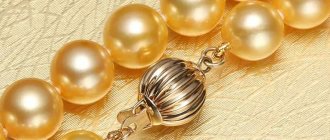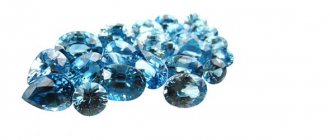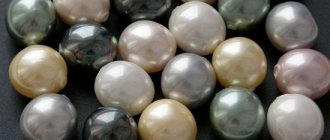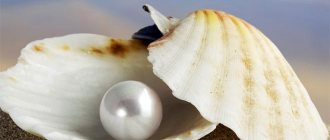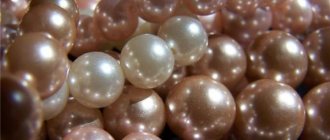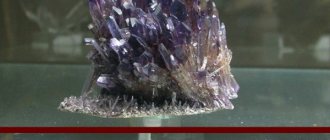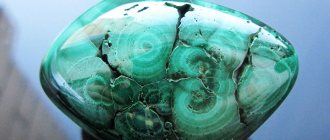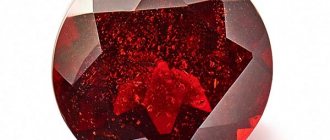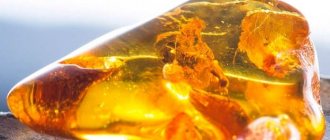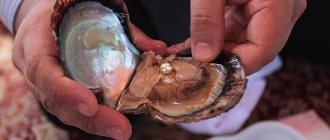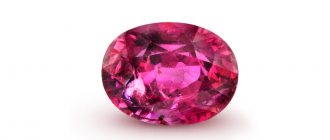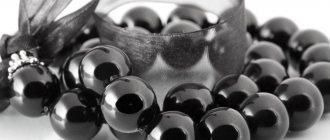Romantic stories, legends and beliefs are associated with this precious mineral. The most famous pearl is “Peregrina”, which was owned by Cleopatra, Princess Zinaida Yusupova and Hollywood diva Elizabeth Taylor. No one doubts its authenticity, but with other copies it is more difficult.
How to distinguish real pearls and avoid making mistakes when buying? There are several ways.
Assortment offered by the market
The romantic halo of pearls makes them the object of desire for many. However, in natural conditions it grows slowly, is difficult to obtain, and costs prohibitively. People have learned to grow beautiful balls on their own. Therefore, it is worth distinguishing between natural and cultivated material. The most affordable price segment is made from polymers. We wrote more about the types, properties and who is suitable for pearls here.
Natural
There are two types of pearls in nature: sea and river. The former are five to six times more expensive than the latter. This is not surprising - to find one high-quality pearl, you need to pull half a ton of mollusks out of the water. Freshwater river material is easier to obtain; its distinguishing features are not always an ideal shape and a weak shine.
Sea pearls of impeccable shape and shine are more often found at auctions than in stores.
Cultured
It is not considered a fake, although it is created by people. The technology is as follows. On a sea or river farm, a core base is placed inside the mollusk. Maturation takes place under natural conditions. After two or three years, a pearl is obtained that is visually indistinguishable from a natural one, but of a certain shape and color. That is, the mother-of-pearl layer is real. The difference is inside: in cultivated specimens it grows around an artificial core.
The thickness of the mother-of-pearl coating depends on the period of creation of the pearl.
High-quality specimens are supplied from farms along the Indian Ocean coast. The world leader is Japan, followed by China, Hong Kong, and the Emirates.
Therefore, when purchasing cultured pearls, find out the country of origin.
Artificial
A product of modern technology. Fake pearls come in several varieties.
Majorca
The production process is multi-stage, so the imitation is very high quality. Only an expert knows how to check the authenticity of pearls in this case. Named after the place of creation in the Spanish city.
Roman
Hollow glass beads with paraffin inside. The method was invented in the Middle Ages, initially it was rough work. Later, pearl essence from fish scales was used for coating, which visually ennobled such artificial pearls.
Shell pearl
Mother of pearl cores coated with varnish. Received in the 1920s. in USA.
Plastic
Frankly low quality products. Sold in jewelry departments.
What is the difference between natural pearls and artificial pearls?
- Inspect the surface carefully. Real pearls will always have some deviations or imperfections. If it looks too good, it's most likely an imitation.
- Inspect the drilled holes. The fake here usually shows unusual wear or flaking. Often a plastic bead is exposed.
- Real pearls are made by nature, so their size should vary slightly.
- High quality pearls will have a deep shine, as if glowing from within.
- A natural pearl usually weighs more than a fake one.
- Inspect the drilled hole. Counterfeits often have traces of melted plastic around the edges.
- Feel the pearls. Is it cool to the touch? The real thing does not heat up to the touch as quickly as the artificial one.
- A real pearl necklace will have depth and color variation. This will include body color and overtone color. Often displaying different colors under different lighting conditions.
- The surface will be rough. Gently rub the two pearls into the strands. If they are a little gritty and you feel some resistance, then they are most likely real.
- What type of clasp is used? Silver or gold are most often used with natural pearls.
- Real pearls in beads are often linked together.
You will also be interested to learn about the different forms of pearls and the reasons for their formation.
I wish you good luck in choosing jewelry!
Recognition methods
Many instructions have been invented explaining how to distinguish natural pearls from artificial ones. Actions are divided into visual, mechanical and formal.
Video: How to distinguish artificial pearls from natural ones?
Visual
Conducted at home. The following characteristics are assessed:
- weight;
- surface cleanliness;
- shine;
- structure.
It is believed that they are practically not counterfeited, because it's difficult.
Weight
The most advanced polymers are not able to replicate the weight parameters of pearls, so simply by holding a bead, it is easy to find out whether it is a natural material.
Pure mother of pearl is heavier than glass or plastic. It is made heavier by the natural stone - the core, around which layers of pearls grow.
Before determining whether pearls are natural or artificial, consider the following:
- When making pearls, mother of pearl is added, so the weight of the artificial product is close to natural;
- An artificial colored mineral is sometimes made from germanite (black pearls are obtained) or coral (pink) - it is heavier than real analogues.
Colored natural pearls are more expensive than white ones. If upon purchase it turns out to be the other way around, then it is a painted fake.
Surface
Nature rarely creates perfectly smooth, clean surfaces. Even elite pearls have small flaws in the form of indentations or roughness. Cultivated specimens are smoother, but also not flawless. The smoothest pearls are natural from auctions or synthetic.
Natural pearls have randomly located spots. They are formed by conchiolin and shine less than the main background in the light.
Shine
The quality of gloss is determined in natural light. Based on this feature, the origin of pearls is determined near a window or on the street.
In a natural specimen, light creates bluish, pinkish or other tints on the surface. It is impossible to obtain them by treating the product with the best varnish or pigment.
A variety of shades is not a defect, but a normal property of natural material. Uniformity, sameness of colors and shades indicates that the selected pearls are of artificial origin.
Structure
Glass or polymers used to imitate natural pearls are easily recognized by their smooth, smooth surface.
In natural material, it is porous and layered, because in natural conditions the core grows in layers slowly, by 0.25–0.35 mm per year, that is, the creation of even a two- to three-millimeter bead takes years.
You can examine the surface in detail and distinguish a fake under a microscope or magnifying glass.
The easiest way to identify beads is by this feature. When choosing a necklace, you need to look at the edge of the inner hole through a magnifying glass. If the beads were coated with paint, its accumulation will be noticeable. Sometimes stone or glass can be seen under the paint.
Form
A fake pearl is perfectly round. However, such natural specimens are rare; oblong, oval, and pear-shaped ones are more common.
Mechanical
Not all methods are safe or easy to apply, but to know how to distinguish pearls, they are taken into account.
Dental check
This is the first thing they recommend doing to check your pearls.
A real mineral creaks when it comes into contact with teeth. Pearlescent powder remains on them, and the unevenness of the surface is felt. Chemicals and glass can be identified without problems in this way.
However, not every salon will allow such an experiment.
Friction
Pearls rub against each other. If they are natural, pearl dust will appear at the friction site, but the surface will not be damaged.
Conducting an in-store experience is also problematic.
Strength
Natural pearls are indifferent to mechanical stress. When checking the pearl for authenticity, it is dropped onto the table. Impact result:
- natural - the appearance of cracks or scratches that are easy to erase;
- glass will crack or break;
- polymers will remain intact.
Heavy natural pearls fall like a stone, light plastic bounces like a ball.
Fitting
You can easily determine its authenticity by holding the bead in your hands or trying on the necklace. At any temperature you will feel the coolness emanating from natural samples. The jewelry will reach room temperature and will quickly heat up in your hands.
X-ray
The photo will reflect the inside of the pearl - density, structure, and other characteristics.
Ultraviolet
To determine the origin, the specimen is placed under an ultraviolet lamp or similar light source. The natural mineral creates a gentle blue glow, the cultivated one creates a greenish glow.
Fire
Whether pearls are natural or not can be determined by applying heat. Nothing will happen to natural things even near fire.
Vinegar
The method is rather theoretical, since only a fake can remain unharmed in strong vinegar. If the pearl dissolved, it means it was real.
Formal
No interaction between the buyer and the precious mineral is required. But the question of how to reliably determine whether a real pearl is real or not is removed.
Price
One of the most reliable methods. Natural pearls, including cultured ones, are never cheap. It is not offered at attractive prices, since the first one is rare, the second one takes a long time and is labor-intensive to grow.
For example, an ideal 10 mm sea pearl is valued at $400, and the same 15 mm is already $1,500. It’s better not to count how much the necklace will cost.
Plastic or glass analogues are two orders of magnitude (a hundred times) cheaper.
Place of purchase and documents
To avoid problems with distinguishing natural pearls from fakes, beads or jewelry are purchased at a reputable salon. But even if the product is from trusted manufacturers, it is a good idea to request a quality certificate.
Visit to a specialist
In order for doubts to be completely dispelled, a professional analysis of the jewelry using special instruments is required. Gemologists or jewelers have them.
Rub the beads together
This verification option is suitable for a bracelet, earrings or pearl beads. It is necessary to have several samples of pearls that can be rubbed against each other. At the moment of contact, if the material is genuine, you will feel an increasing force of friction. This is again due to the imperfect top layer. Fake mother-of-pearl beads will begin to slide when rubbed and produce an unpleasant artificial sound.
At the end of the test, look at your fingers in daylight. After contact with natural pearls, a little pearlescent dust remains on the skin.
“Wild” or the most natural – how it is formed and what it is
Mining natural pearls is an activity that contradicts the humane attitude towards all living things. Not everyone knows that in order to find 5-10 pearls, you need to kill at least 100-150 oysters. And only a third of the extracted treasures will be suitable for further processing and use.
In the modern world, pearl mining on a large scale is practically not carried out and is prohibited. Seafood is only sometimes found by chance by farmers and fishermen.
Available methods for determining the naturalness of jewelry
If you want to quickly and efficiently check the authenticity of your purchased jewelry, you can use one of the options below.
- Visually assess the quality of the beads.
Important! Real specimens have an uneven shape, unlike artificial versions.
Look at the pearls, they should have an uneven pear or egg shape .
- When visually assessed, you can see an interesting play of color . Real mother-of-pearl, when exposed to light, begins to shimmer with white, yellow and pink shades .
- High-quality pearls should sparkle in good lighting. When you visually examine it, you can see your reflection on the surface.
- Remove the pearls from the string and look at the hole in the center . It is necessary to evaluate its edges and the course of the channel itself. On real pearls you can see a perfectly smooth channel with clear edges. Outwardly, it will resemble an ideal cylinder with a cavity. In the case of artificial material, an uneven curved channel with rounded edges is noticeable.
- A careful examination of the channel reveals characteristic lines indicating the presence of several layers of mother-of-pearl coating . In the case of this option, you will see a clear border (one line) of the transition of nacre to the core. Fake versions of these lines may have several or none at all.
Since none of the presented criteria can unambiguously indicate the authenticity of a product, it is necessary to take them into account as a whole. Such an assessment will help to most accurately determine the authenticity of the product.
What methods are better not to use to check the naturalness of pearls?
You can often find additional methods for checking the authenticity of pearl jewelry on the Internet. However, not all of them may be suitable.
The least effective verification methods that can damage the product include several options.
- Fire testing is a dangerous and ineffective method. Because some types of real pearls can also burn, as well as artificial varieties.
Important! When exposed to fire, pearls become very hot, which can cause burns.
- Quality assessment using teeth and friction . Real pearls should have a rough surface. However, with careful polishing, the surface can become smooth, just like artificial options.
- Do not check jewelry with vinegar . In the case of the genuine version, you will simply lose the decoration, since it will dissolve in acetic acid .
And remember: exotic names are not an indicator of the authenticity of the products!
What jacket to wear in the fall to look stylish
16 interesting facts about bedding
